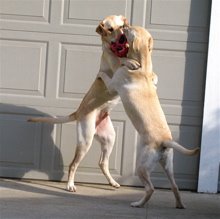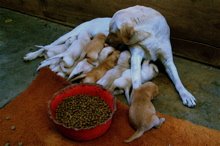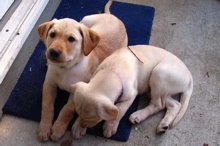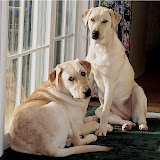Surviving Puppy Adolescence
Hitting the skids . . .
Everything seemed to be going well until my two dogs hit adolescence. Then things really changed. It didn't help that I had majorly sprained my ankle as they were entering this stage and the weekly hikes came to a complete stop. When we headed back out over a month later all hell seemed to have broken loose. Hiking became a complete battle. With two 7 month old Labradors vs. My arm, shoulder and neck I was losing and losing fast!! Beginning obedience had gone so well with my two labs out performing in every way. My husband and I were so proud. Now intermediate obedience was off to a bumpy start with things going from bad to worse. The suggestions from our first trainer were worthless. I felt she was at more of a loss than we were. She should have been able to help. She was a trainer!! The class format left no room for helping with our challenges and we dropped out and lost half our money - for two dogs. I began my research in earnest at that point. I searched every where for some insight as to how to work with the personality components of a Labrador through this stage of development. I finally found some links that began to make sense of what we were going through.
• Surviving Your Puppy's Adolescence, by Tehani Mosconi
• Puppyhood and Beyond, by Sue St. Gelais
This was the best I found. The second link really helped put things into perspective. But there were still no details on how to deal with my specific day to day issues.
The simple act of taking a walk had become a nightmare. Shelby, our boy, would bark and whine incessantly. Any distraction from a bird or squirrel set him into fits and boy could he bark. Nutmeg, our girl, would take her cues from him and it would go from bad to worse in a heart beat. We were lucky if I could take it for more than a block.
I franticly searched through Amazon's dog training books and the recommendations for each book. Soon I was more confused than when I started. Then by some miracle I found the "Dogwise" web site and the books by Turid Rugaas. I cried as I read her book "On Talking Terms with Dogs: Calming signals". Finally, I began to understand that they had been trying to communicate with me despite their change in behavior. I now understood when they were trying to calm themselves down, when they were trying to calm me down, and how I could help calm them down in turn. I learned that I could help facilitate the valuable calming behaviors shown here "Calming Signals Picture Gallery". Skills they needed to continue with their training despite the increased impulsivity and highly distractable stage they had entered. Not to mention, these skills were vitally necessary for them to have in order to safely and properly communicate with other dogs they interacted with.
It was also around this same time as well that good fortune also allowed me to find an awesome trainer. The first time we talked Trish spent twenty minutes on the phone with me and never once mentioned that her usual fee is $35/ half hour. Then, knowing full well what was going on with my dogs, she invited me to a class that had been going already for two sessions. A generous offer as a new dog with issues was going to be added to a class just settling down and working well together. I decided to take Shelby as he was the worst offender. Shelby added his fair share of chaos to the class. Trish was patient and understanding. At the end of class Trish worked with us one on one and showed me in a matter of minutes that simply ignoring him until he calmed down was the first and biggest step towards changing his behavior. I didn't need to respond to his bad behavior to effect the change I wanted, I needed to ignore it. As soon and he would stop his whining he immediately got a treat. If he jumped up he was immediately given her back. Quickly taking cues from her that night I ignored him completely but stayed close, giving him my back and offering no eye contact unless he was quite or calm. It was amazing the change in him in just five minutes. Even so they were the longest five minutes of my life.
Things changed dramatically at home after that. When my husband came home from work he would ignore the dogs until they were calm. He would stay in the same space as them but they got no affection or eye contact or verbal acknowledgement until they were calm and quite. By the end of the week the over excitement level at arrival moments was gone within seconds not minutes. We had made a big baby step, but it was only the beginning. The incessant barking during walks took three month to fix. Huge improvement happened in the first month giving me the encouragement I needed to keep going. But they were the longest months ever in the first year.
I found another good book during this time:
• Canine Body Language: A Photographic Guide.
I quickly realized after reading Turid Rugaas's book that the more I understood what my dogs were saying to me the more I knew what I needed to do so they understood me. I was more sensitive to there needs because I could make sense of their body language. Trish did warn me to take this book with a grain of salt. The book goes into extensive detail describing the slightest changes in facial expression and puts a label on it. Even I found that keeping it simple and looking for generalities makes more sense. Is your dog happy, sad, fearful, relaxed, or negotiating. These are the basic simple things you need to be able to see, not just in your dogs but in the dogs you encounter in the community while walking your dog. Here's a great article from another very generous trainer that has posted articles to the web:
• The Fine Art of Observation, by Suzanne Clothier
We continued with the training classes with Trish and even she was pleased with the changes. In every class there was always compassion and empathy from her and new tricks to try for the next week. Things began to turn around. I was getting my dogs back and learning more and more about them every day. I was falling in love, head over heals in love!!















1 comment:
Hi! I know this an older post, but it really resonates. In the last few weeks, Booker, our rescued coonhound, is becoming a barking nightmare on the leash. We live in a condo and have had a few nasty encounters with lunging, nipping little terrors on zippy leashes ... now Booker isn't even WAITING for an incident. I can hardly blame him, but we need to work on this -- he makes BIG noise in the elevator lobby!
Anne rescueacoonie.blogspot.com
Post a Comment